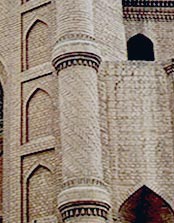The Xinjiang Uygur Autonomous Region has been inhabited by various ethnic groups for many ages. The Islamic architecture of the region reflects the diverse tastes of different peoples through centuries of time, yet it also signals an underlying unity of belief and thought.
The mosques, minarets and tombs, along with their beautifully crafted appointments, serve as a rich expression of the Islamic faith and local aesthetics. They form an important part of China's traditional and modern culture.
These buildings stand as the region's historical heritage, as well as witnesses to social and cultural change. In addition to being centers of worship, they attract non-Muslim visitors and scholars, and are under state protection as both historic and tourism sites.
Hand in hand with the rest of the nation, Xinjiang residents have contributed a great deal to Chinese civilization. Likewise, the Islamic architecture of the region reflects the influences of the Han.
Xinjiang boasts astounding natural wonders: azure skies, vast deserts, gem-like oases, snow-capped mountains and emerald pastures. Yet the Islamic architecture in its cities and towns rival the splendor of nature. Their superb design and craftsmanship, profound symbolism and artistic elegance inspire awe in every visitor, whether Muslim or not. |



















